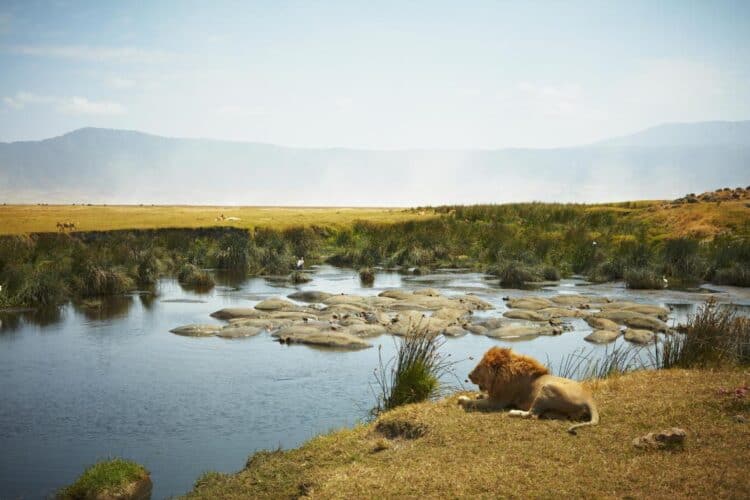In 2015, the killing of Cecil the Lion shocked the world. An American trophy hunter paid tens of thousands of dollars to bow-hunt Cecil, a lion being studied by researchers and beloved by wildlife viewing tourists at Hwange National Park in Zimbabwe. Tragically, Cecil did not die right away and spent hours in agony before the hunter finished him off with a gunshot the next day.
While Cecil’s death illuminated the dark under-belly of the trophy hunting industry, unfortunately it didn’t end it, and trophy hunting still exists throughout the world today. We are still being bombarded with story after story of grisly acts against wild animals by trophy hunters.
Trophy hunters are not motivated by conservation. On the contrary, trophy hunters kill wild animals for fun and bragging rights. They compete with one another for prizes from trophy hunting industry groups; to earn the top prize from Safari Club International, a trophy hunter would have to kill over 300 wild animals in several categories; categories include “Bears of the World,” which requires a hunter to kill bears of five different species; there are nearly 50 such categories.
Trophy hunting harms conservation by causing population declines, as has been documented by scientists studying lions and leopards. Trophy hunting deliberately removes strong, fit male animals with prominent features such as large horns, big tusks or dark manes – characteristics attractive to trophy hunters that motivate them to kill in the first place.
In other words, trophy hunting is completely at odds with the nature’s “survival of the fittest” selection process by removing dominant male animals who contribute to a vibrant and diverse genetic pool. The removal of these dominant males sets off a cascade of effects that results in the deaths of more animals.
For example, in lions, when a pride male is killed by a trophy hunter, another male will take over his pride, killing all the cubs, and often even the females who attempt to defend their cubs. Further, when trophy hunters kill female animals (such as leopards, who are difficult to distinguish from males), there are additional repercussions on the imperiled species’ ability to sustain populations.
The Humane Society of the United States and Humane Society International compiled a list of egregious trophy hunting stories in 2019 ahead of Safari Club International’s annual convention in Reno, Nevada in February 2020, where trophy hunters from around the world will gather to buy trophy hunts and wildlife products.
While the trophy hunting industry claims to promote wildlife conservation, these stories show the true ugly nature of the industry.
Terrible Ten Trophy Hunting Stories:
- At Safari Club International’s annual trophy hunting convention in January 2019 in Nevada, an undercover investigation by HSUS and HSI found vendors peddling captive-bred lion hunts in contravention of SCI’s own policies. Some vendors offered for sale the body parts and products of imperiled species such as elephants and hippos, in apparent violation of Nevada state wildlife trafficking laws.
- In February 2019, Pakistanis reacted with indignation when a video and photos emerged showing an American trophy hunter from Texas, smiling alongside the markhor he paid $110,000 to kill in Pakistan. This imperiled species of mountain goat is Pakistan’s national animal.
- A 2011 video featuring an American trophy hunter from Illinois sneaking up on and killing a sleeping lion in Zimbabwe, surfaced in March 2019. The video shows the man receiving congratulations from his companions as the wounded lion writhed in pain on the ground.
- A trophy hunter covered in blood posed with the mountain lion she had just killed in Colorado.
- South African authorities discovered 108 lions suffering in terrible conditions at a captive-breeding facility that supplies lions for canned hunts in May.
- An American trophy hunter from Kentucky who widely shared photos of a giraffe she had killed in 2018 re-ignited controversy and headlines in June 2019, when she bragged about her kill and stated in an interview that the giraffe meat “tasted delicious” and the skin would make fabulous pillows. A 2018 HSUS investigation into the sale of giraffe-skin pillows and other products led New York to recently become the first state in the U.S.— and the world —to ban the trade.
- A Canadian couple who posted a photo of themselves in July kissing over the dead lion they’d just killed in South Africa demonstrated their remorseless killing of an animal threatened with extinction. The lion allegedly came from a captive breeding facility.
- In September it was reported that the Trump Administration allowed a Michigan trophy hunter to import parts of a critically endangered black rhino he paid $400,000 to kill in Namibia.
- In December 2019, ProPublica released the news that Donald Trump Jr., known for his trophy hunting, had killed an imperiled argali sheep in Mongolia without a permit earlier in the year. Trump Jr., is the scheduled keynote speaker at the February 2020 Safari Club International convention, which will auction off a trophy hunting trip with him.
- Two people in charge of a hunting party that killed five elephants in Botswana had their hunting licenses revoked by the government. Because the killing of collared animals is not permitted in Botswana, the hunters destroyed one elephant’s collar to hide the evidence of their crime.
HSUS and HSI are fighting to end trophy hunting throughout the world. Wild animals should be protected in the wild, not exploited and killed for bragging rights. Join us in urging the U.S. Fish and Wildlife Service to deny Donald Trump Jr the import of his argali trophy.
This article was first published by OneGreenPlanet on 2 February 2021. Lead Image Source: Humane Society of the United States.
What you can do
Support ‘Fighting for Wildlife’ by donating as little as $1 – It only takes a minute. Thank you.







Leave a Reply